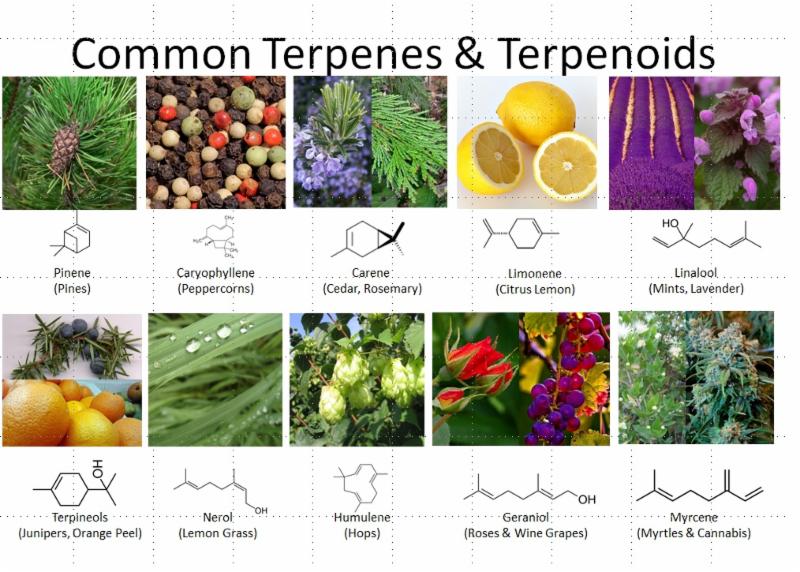Terpenes are the aromatic metabolites found in the oils of all plants. Terpenoid production evolved over time in plants, including cannabis and hemp, to attract pollinators and to act as defense compounds. Terpenes play important roles in plant interactions, plant defenses and the other environmental stresses.
Terpenes offer special medicinal and therapeutic benefits that help with everything from insomnia to infections to depression.
Here are the top ten things you need to know about terpenes:
1. Terpenes aren’t unique to cannabis.
You can find terpenes in most plants and foods. Myrcene is found in mango, bay leaves and lemongrass; limonene is found in peppermint, rosemary and fruit rinds. Scientifically, these fragrant chemicals called hydrocarbons make food and plants smell the way they do.
2. More than 20,000 terpenes have been identified.
There are more than 20,000 terpenes in existence and at least 100 produced by the cannabis plant. These powerful building blocks can comprise as much as 25 percent of the total oil produced by the plant’s trichome gland. Differences can be subtle, but each cannabis strain has its own terpene content and composition.
3. Cannabis plants thrive because of terpenes.
It’s believed that these pungent smells developed to repel predators, attract pollinators and enhance plant development.
4. Terpenes directly affect your senses.
Escape to the woods with borneol, satisfy your citrus craving with linalool, or refresh your tastebuds with pulegone. A terpene’s makeup correlates to identifiable smells and tastes, explaining why many think Sharks Breath smells like seafood or Blue Dream tastes like mint.
5. Terpenes and CBD are partners in healing.
These chemicals affect our endocannabinoid system just as much as THC and CBD. In fact, terpenes interact synergistically with cannabiniods to affect the psychoactive area of your brain, as well as the blood-brain barrier that changes chemical outputs. Can you say “entourage effect”?
6. Terpenes have serious therapeutic power.
The list of benefits for terpenes is long and many have been heavily researched.
Find a strain with high levels of caryophyllene for anti-inflammatory and arthritis relief. Consider something with linalool if you’re breaking out, or pinene when you’re feeling blue.
View a comprehensive list of benefits from the terpenes used to flavor Luvitol Vanilla Mint Tincture and Luvitol Orange Vanilla Tincture
7. Extraction is key.
Terpenes automatically contain the smell we’ve come to recognize, but cannabis/hemp extraction methods can significantly alter the end product’s terpene profile. Ratios are affected by climate, plant maturation and time of day, and can diminish when high heat is involved. Many products found today use a CBD distillate or isolate, which contains little or no terpenes. Always look for a full spectrum crude extract with a rich terpene profile.
8. Terpene content can diminish over time.
A plant is likely to have lower levels of terpene content a week after harvest, and those levels drop quickly if your bud is improperly stored. It’s been found that a few types of terpenes evaporate faster than others in environments with inadequate lighting and temperature. Take a sniff to see if the smell has changed since you purchased your bud at the dispensary.
9. More mapping, more manipulation.
As researchers learn more about terpenes, they become easier to predict and control. With this power, we can create distinct combinations between flavors and medical benefits for specific needs and wants.
10. We need to know more!
Terpene knowledge will only enhance industry understanding, awareness and opportunities. Many cannabis analysis labs are already testing for terpene content and synergistic ability, but we’re just getting started down the terpene path.

